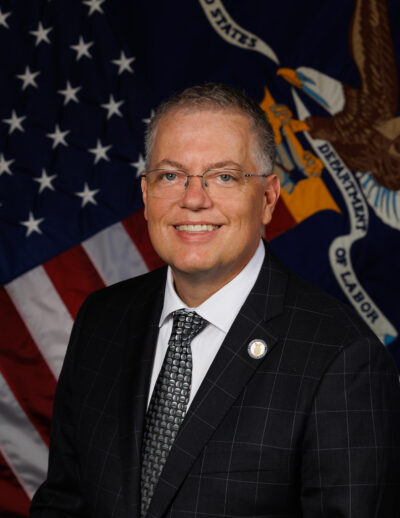From muddy caves to D.C. boardrooms, decades of worker safety leadership earns Purdue Health Sciences alumnus a top position in the U.S. Department of Labor

Jim Frederick
Written by: Tim Brouk, tbrouk@purdue.edu
Every morning, 1990 Purdue University Health Sciences alumnus Jim Frederick wakes up in his Washington, D.C., home thinking of the number 15.
The number is the average amount of daily worker deaths in the United States — deaths that could be avoided if facilities, companies and industries followed the rules and tips set forth by the Occupational Safety and Health Administration, better known as OSHA. As deputy assistant secretary of labor for the federal program, Frederick sees OSHA not as the safety police but as a life-saving resource for workers, both on the clock and off.
“As I get moving in the morning, it’s putting in context the importance of the work that we do at this agency,” said Frederick. “It’s also a motivation for me because it’s not only what we’re doing but why we’re doing it.”
The Elkhart, Indiana, native studied environmental health and industrial hygiene, programs now held in the Purdue College of Health and Human Sciences (HHS). Frederick will receive an HHS Distinguished Alumnus Award on March 22.
Plucked from retirement in January 2021 by President Joe Biden’s transition team, Frederick led OSHA for 11 months until assistant secretary of labor Doug Parker was hired. Today, Frederick still leads numerous worker safety initiatives that are applied nationally.
More than forklift safety
In just three years, Frederick led plans on multiple post-pandemic work safety concerns. Airborne illnesses such as COVID-19 rose to prominence in the workplace and more had to be written than just asking workers to stay home when feeling sick. The work is especially vital for workers in health care settings. Frederick said the framework for official OSHA rules on infectious disease transmitted through the air is underway and is a high priority for him and his team.
Workplace violence in health care facilities was a major, recent topic as well. Disagreements between workers or between workers and patients are one thing, but Frederick saw OSHA as being a resource to recommend control measures that should be in place to reduce the risk of serious injury to health care workers from patients who often don’t recognize the harm they may cause.
“Much of the work that we’re doing today is going to have long-lasting impacts; some of it we won’t see over the course of time that we’re here, but it will have long-lasting impact for the agency,” Frederick explained.
Saskatchewan mud and D.C. boardrooms in one week
Prior to his government position, Frederick spent 25 years as the assistant director and principal investigator for the United Steelworkers (USW) Department of Health, Safety and Environment. Obtained soon after he earned his master’s degree from Rochester Institute of Technology, this position took Frederick all over the nation and sometimes to other countries. Canadian potash miners were seeking his guidance about working conditions in a cold, damp Saskatchewan underground mine. Frederick was “boot-deep” in mud while surveying the conditions. Two days later, he was wearing a suit and tie at USW meetings in congressional offices in Washington, D.C.
Frederick spent many days working in his home state, namely in steel plants in Northwest Indiana. As the years passed, Frederick realized USW’s reach. He visited diverse and large local unions at raw materials sites such as those in Gary, Burns Harbor and Portage, Indiana, building sites; aircraft carrier manufacturing in Newport News, Virginia; health care facilities in California; and even a research facility maintained by the University of Toronto — again in Canada.
“The importance of that work that occurred in those facilities over our whole lifetime-plus has been vital to the economy of this country and the safety of the country,” Frederick said. “Every time we drive across a bridge or walk into a building and go to a higher floor, we know that there are materials that were made in those workplaces.”
Sights — and smells — of Purdue
Purdue’s West Lafayette campus was always Frederick’s college destination because his father and siblings were all Boilermakers, and some of his fondest childhood memories were riding with his dad to Purdue football games. While the action in Ross-Ade Stadium was memorable, he can also recall the smells of grilling burgers and the sounds of amped fans at tailgating parties as he made his way toward the gridiron.
Years later, Frederick remembers the very first Purdue class he took. That 8:30 a.m. Monday class is not etched in his brain because of the content; it’s where he met his future wife, Nancy Hoog (Industrial Engineering ‘90). The two first talked during that class and became friends.
“We didn’t date until we were seniors, but we were friends throughout. I wasn’t so happy to have that early COM 114 class, but I’m really glad that we did,” Frederick smiled.
Purdue was also the place where Frederick found his career passion for workplace safety, which still motivates him. Every Friday evening, Frederick goes back to his crowded work calendar and highlights three things that addressed worker safety that week. His goal is to reduce that morning 15.
Discover more from News | College of Health and Human Sciences
Subscribe to get the latest posts to your email.